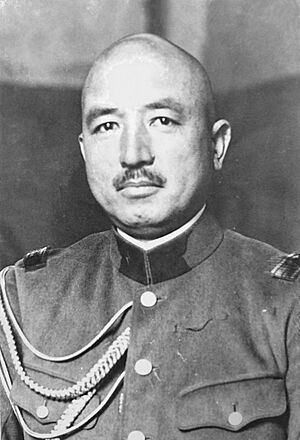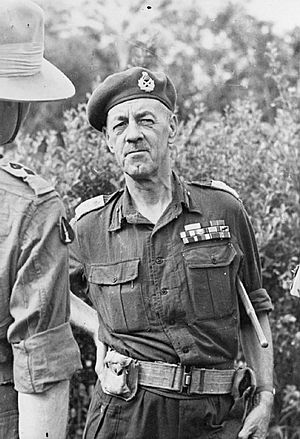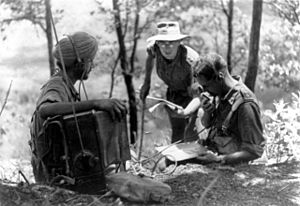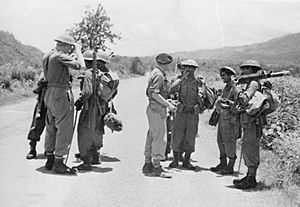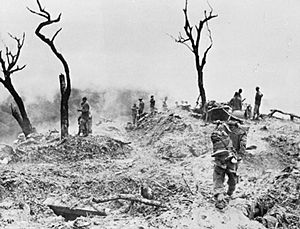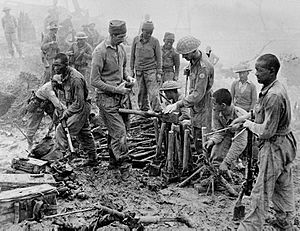Battle of Imphal facts for kids
Quick facts for kids Battle of Imphal(Meitei: Japan Laan) |
|||||||
|---|---|---|---|---|---|---|---|
| Part of the Operation U-Go during the Burma Campaign in the South-East Asian theatre of World War II | |||||||
 Gurkhas advancing with Grant tanks to clear the Japanese from Imphal-Kohima road in North Eastern British India |
|||||||
|
|||||||
| Belligerents | |||||||
| Commanders and leaders | |||||||
| Strength | |||||||
| 4 infantry divisions 1 armoured brigade 1 parachute brigade |
3 infantry divisions 1 tank regiment 2 Indian regiments |
||||||
| Casualties and losses | |||||||
| 12,603 killed and wounded | 54,879 killed and wounded | ||||||
The Battle of Imphal was a major battle during World War II. It happened in 1944 near the city of Imphal in Northeast India. Japanese armies tried to invade India by destroying the Allied forces at Imphal. However, the Allies pushed them back into Burma.
This battle, along with the Battle of Kohima, was a turning point in the Burma campaign. The Japanese suffered huge losses, many from starvation and disease. In 2013, the British National Army Museum voted the Battle of Imphal as Britain's Greatest Battle.
Contents
Why the Battle Happened
The Japanese Plan
In 1943, Lieutenant General Renya Mutaguchi took command of the Japanese Fifteenth Army in Burma. He strongly believed they should invade India. He thought this would be a decisive victory for Japan. He might have been encouraged by a British raid behind Japanese lines earlier in 1943.
By early 1944, Japan was losing the war in other areas. The Allies were getting ready to attack Burma from India and China. Imphal was a big Allied supply base with airfields and supply dumps. It was connected to another large base at Dimapur by a road through the Naga Hills.
Mutaguchi wanted to capture Imphal and then move into the Brahmaputra River valley. This would cut off Allied supplies to northern Burma and China. His plan was called Operation U-Go.
Here's how Mutaguchi planned the attack:
- The 33rd Infantry Division would attack Imphal from the south.
- A special group called Yamamoto Force would attack Imphal from the east. This group included tanks and heavy artillery.
- The 15th Infantry Division would attack Imphal from the north.
- The 31st Infantry Division would capture Kohima to cut off Imphal from the north.
Subhas Chandra Bose, the leader of the Azad Hind (Indian National Army), also played a part. His soldiers helped the Japanese, especially with scouting and trying to get British Indian soldiers to switch sides.
Japanese commanders worried about supplies. Mutaguchi thought the battle would end in three weeks. After that, supplies would be hard to get, especially with the monsoon rains starting in May. He hoped to capture Allied supplies. He also planned to use cattle for food, but many died.
The Japanese also thought British tanks couldn't be used in the hills. So, they left most of their anti-tank weapons behind. This was a big mistake. Also, Mutaguchi believed British and Indian soldiers were not good fighters. But by 1944, Allied troops were much better trained.
Allied Defenses
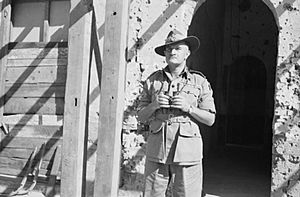
The city of Imphal was defended by the IV Corps, led by Lieutenant General Geoffry Scoones. This corps was part of the Fourteenth Army, commanded by Lieutenant General William Slim.
Allied units were spread out near the Chindwin River. This made them easy targets for being cut off.
- The 20th Indian Infantry Division was at Tamu, southeast of Imphal.
- The 17th Indian Infantry Division was at Tiddim, south of Imphal.
- The 23rd Indian Infantry Division was in reserve around Imphal.
- The 50th Indian Parachute Brigade was north of Imphal.
- The 254th Indian Tank Brigade was in Imphal.
Indian divisions had both British and Indian soldiers. They were supported by artillery.
Before the main battle, the Japanese tried a similar attack in another area. It failed because Allied planes dropped supplies to cut-off troops. Also, the Japanese were surprised by Indian tanks. These lessons helped the Allies, but the Japanese didn't change their plans.
Even as the Japanese prepared, the Allies launched a special operation with Chindits (long-range jungle fighters). Mutaguchi ignored warnings about these Chindits, thinking he would capture their air bases soon.
Battle Begins
Slim and Scoones knew a big Japanese attack was coming. They planned to pull their troops back to the Imphal plain. This would force the Japanese to fight far from their supplies. However, they misjudged when and where the Japanese would attack. Japanese troops crossed the Chindwin River on March 8. Scoones ordered his troops to withdraw only on March 13.
Fighting in the South and East
The 20th Indian Division was at Tamu. On March 20, British Lee tanks destroyed six Japanese tanks. The Indian division then withdrew to the Shenam Saddle, a hilly area on the road to Imphal. They burned their supply dump at Moreh.
Further south, the 17th Indian Division was cut off by the Japanese 33rd Division. The Indian division began to withdraw on March 14. They fought their way through Japanese roadblocks. They managed to save most of their vehicles and supplies.
Both sides suffered many casualties. The Japanese commander, Yanagida, was cautious and didn't press his attack. Scoones had to send his reserve troops, the 23rd Indian Division, to help the 17th Division. Both divisions, supplied by air, reached the Imphal plain by April 4.
Fighting in the North
Imphal was now open to attack from the north by the Japanese 15th Division. The Indian 50th Parachute Brigade fought a tough battle at Battle of Sangshak against the Japanese 31st Division.
However, the Allies had a big advantage: air power. Admiral Louis Mountbatten, the Allied commander, used transport planes to move the experienced 5th Indian Infantry Division from another front to Imphal. This move took only eleven days. By April 3, these troops were fighting north and east of Imphal.
Stalemate and Counter-attacks
By early April, Japanese attacks slowed down. The Allies started to counter-attack the Japanese 15th Division in the north. This division was the weakest, and defeating it would break the siege.
North of Imphal
The Japanese 15th Division captured a supply dump north of Imphal, but it was empty. A Japanese battalion also seized Nungshigum Ridge, which overlooked Imphal's main airfield. On April 13, the 5th Indian Division counter-attacked. They were supported by air strikes, artillery, and M3 Lee tanks. The Japanese didn't expect tanks on such steep slopes. The Japanese were driven off the ridge with heavy losses.
The Allied counter-attack was slow because of the monsoon rains. Also, they had to save artillery ammunition. The 5th and 23rd Indian Divisions tried to capture steep ridges held by the Japanese. These positions were very strong.
By May, the Japanese were exhausted and starving. Lieutenant General Sato, commander of the Japanese 31st Division at Kohima, ordered a retreat to find food. This allowed Indian XXXIII Corps to push the Japanese away from Kohima and advance south.
The Japanese 15th Division also ran out of food. Their soldiers had to leave their positions to search for supplies. On June 22, Allied troops from Imphal and Kohima met at Milestone 109, north of Imphal. The siege of Imphal was officially over.
South and East of Imphal
South of Imphal, the 17th Indian Division faced the Japanese 33rd Division. There was heavy fighting in May. The British lost 12 tanks in one battle.
The Indian 48th Infantry Brigade tried to attack the Japanese from behind. They cut the road on May 18, but couldn't link up with other Indian units. They had to fight their way back with heavy losses.
A new Japanese commander, Lieutenant General Nobuo Tanaka, took over the 33rd Division on May 22. He ordered more attacks, but his troops were too weak. By the end of June, the 33rd Division could no longer fight.
End of the Battle
The Japanese leaders knew by May that the operation was failing. But they didn't want to take responsibility for ordering a retreat. Finally, on July 3, Mutaguchi ordered the offensive to stop.
The Japanese soldiers, many sick and wounded, retreated to the Chindwin River. They left behind their artillery, vehicles, and many dead or dying soldiers. The Allies recaptured Tamu in late July. They found many Japanese bodies there.
Casualties
The Japanese suffered a massive defeat. They had over 54,000 casualties, including more than 13,000 dead. Most of these deaths were from starvation, disease, and exhaustion.
The Allies had about 12,600 casualties.
Aftermath
The Japanese also lost almost all their pack animals and trucks. This made it very hard for their divisions to move supplies later on. Mutaguchi and Kawabe, the Japanese commanders, were later removed from their positions.
In December, British commanders, including Slim, were honored at a ceremony in Imphal.
Air Power in the Battle

By mid-1944, the Allies completely controlled the skies over Burma. The Japanese air force had suffered heavy losses earlier. During the Imphal and Kohima battles, they could only make a few small raids.
Allied planes provided close support to ground troops. They bombed Japanese positions, supply dumps, and roads. Even during the monsoon rains, Allied air activity increased greatly.
The most important help came from Allied transport planes. They flew soldiers, equipment, and supplies into Imphal's airfields. This meant Imphal was never truly cut off. By the end of the battle, Allied planes had flown in 19,000 tons of supplies and 12,000 soldiers. They also flew out 13,000 wounded soldiers and 43,000 non-fighters. They even dropped food and water to surrounded units.
At the start of the battle, there weren't enough transport planes. But Admiral Louis Mountbatten took action and got more planes. This was crucial for the Allied victory.
War Cemetery
After the war, the Commonwealth War Graves Commission created the Imphal War Cemetery and Kohima War Cemetery. These cemeteries honor the British and Indian soldiers who died in these battles.
See also
- Imphal 1944
- Imphal Peace Museum
- India in World War II
- Japan Landa Imphal
- My Japanese Niece


